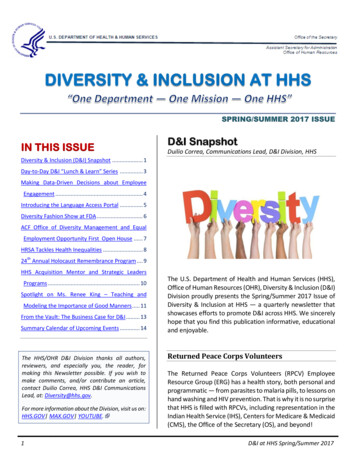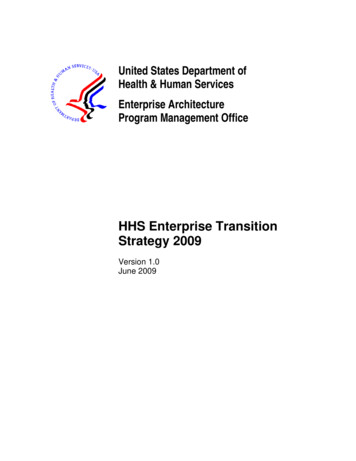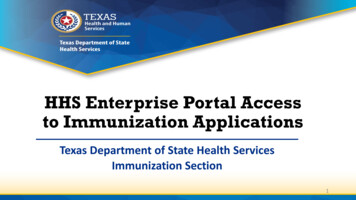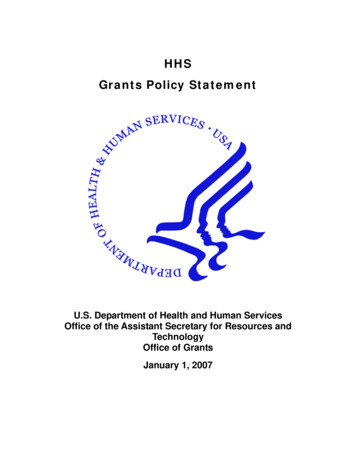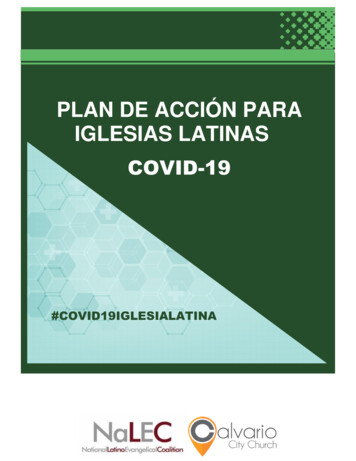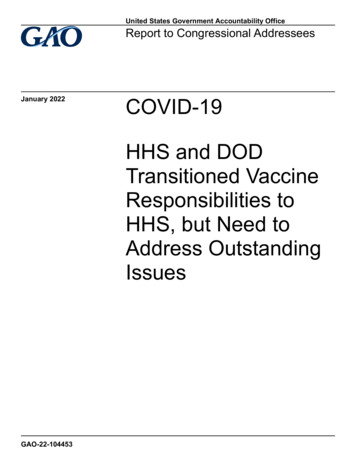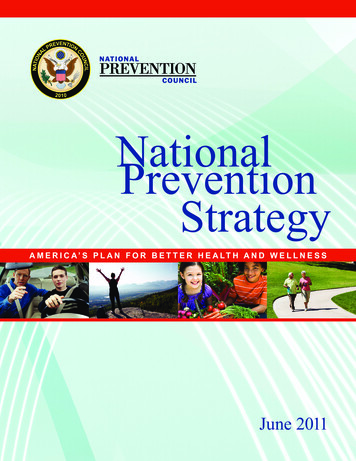
Transcription
NationalPreventionStrategyA M E R I C A’ S P L A N F O R B E T T E R H E A LT H A N D W E L L N E S SJune 2011
National Prevention, Health Promotion and Public Health CouncilFor more information about the National Prevention Strategy, go hc.OFFICE of theSURGEON GENERAL5600 Fishers LaneRoom 18-66Rockville, MD 20857email: prevention.council@hhs.govSuggested citation:National Prevention Council, National Prevention Strategy, Washington, DC:U.S. Department of Health and Human Services, Office of the Surgeon General, 2011.
National Prevention StrategyAmerica’s Plan for Better Health and WellnessJune 16, 2011
2
NationalPreventionStrategyPrevention,Message from the Chair of the NationalHealth Promotion, and Public Health CouncilAs U.S. Surgeon General and Chair of the National Prevention, Health Promotion, and Public Health Council (National PreventionCouncil), I am honored to present the nation’s first ever National Prevention and Health Promotion Strategy (National PreventionStrategy). This strategy is a critical component of the Affordable Care Act, and it provides an opportunity for us to become a morehealthy and fit nation.The National Prevention Council comprises 17 heads of departments, agencies, and offices across the Federal government who arecommitted to promoting prevention and wellness. The Council provides the leadership necessary to engage not only the federalgovernment but a diverse array of stakeholders, from state and local policy makers, to business leaders, to individuals, their familiesand communities, to champion the policies and programs needed to ensure the health of Americans prospers. With guidance from thepublic and the Advisory Group on Prevention, Health Promotion, and Integrative and Public Health, the National Prevention Councildeveloped this Strategy.The National Prevention Strategy will move us from a system of sick care to one based on wellness and prevention. It builds upon thestate-of-the-art clinical services we have in this country and the remarkable progress that has been made toward understanding how toimprove the health of individuals, families, and communities through prevention.The National Prevention Strategy encourages partnerships among Federal, state, tribal, local, and territorial governments; business,industry, and other private sector partners; philanthropic organizations; community and faith-based organizations; and everydayAmericans to improve health through prevention. For the first time in the history of our nation, we have developed a cross-sector,integrated national strategy that identifies priorities for improving the health of Americans. Through these partnerships, the NationalPrevention Strategy will improve America’s health by helping to create healthy and safe communities, expand clinical and communitybased preventive services, empower people to make healthy choices, and eliminate health disparities.We know that preventing disease before it starts is critical to helping people live longer, healthier lives and keeping health care costsdown. Poor diet, physical inactivity, tobacco use, and alcohol misuse are just some of the challenges we face. We also know that manyof the strongest predictors of health and well-being fall outside of the health care setting. Our housing, transportation, education,workplaces, and environment are major elements that impact the physical and mental health of Americans. This is why the NationalPrevention Strategy helps us understand how to weave prevention into the fabric of our everyday lives.The National Prevention Council members and I are fully committed to implementing the National Prevention Strategy. We lookforward to continuing our dialogue with all stakeholders as we strive to ensure that programs and policies effectively help usaccomplish our vision of a healthy and fit nation.Regina M. Benjamin, MD,Surgeon GeneralChair of the National Prevention, Health Promotion, and Public Health Council3
National Prevention, Health Promotion, andPublic Health CouncilMembers 4Surgeon General Regina M. Benjamin, Council ChairSecretary Kathleen Sebelius, Department of Health and Human ServicesSecretary Tom Vilsack, Department of AgricultureSecretary Arne Duncan, Department of EducationChairman Jon Leibowitz, Federal Trade CommissionSecretary Ray LaHood, Department of TransportationSecretary Hilda L. Solis, Department of LaborSecretary Janet A. Napolitano, Department of Homeland SecurityAdministrator Lisa P. Jackson, Environmental Protection AgencyDirector R. Gil Kerlikowske, Office of National Drug Control PolicyDirector Melody Barnes, Domestic Policy CouncilAssistant Secretary-Indian Affairs Larry Echo Hawk, Department of the InteriorActing Chief Executive Officer Robert Velasco II, Corporation for National and Community ServiceSecretary Robert M. Gates, Department of DefenseSecretary Shaun Donovan, Department of Housing and Urban DevelopmentAttorney General Eric H. Holder, Jr., Department of JusticeSecretary Eric K. Shinseki, Department of Veterans AffairsDirector Jacob J. Lew, Office of Management and Budget
Table of ContentsMessage from the Chair of the National Prevention, Health Promotion, and Public Health Council.3National Prevention, Health Promotion, and Public Health Council.4Table of Contents.5Introduction.6National Leadership.8Partners in Prevention.9Strategic Directions and Priorities.11Strategic DirectionsHealthy and Safe Community Environments.14Clinical and Community Preventive Services.18Empowered People.22Elimination of Health Disparities.25PrioritiesTobacco Free Living.28Preventing Drug Abuse and Excessive Alcohol Use .31Healthy Eating.34Active Living.38Injury and Violence Free Living.41Reproductive and Sexual Health.44Mental and Emotional Well-being.48AppendicesAppendix 1: Economic Benefits of Preventing Disease .51Appendix 2: National Prevention Strategy Indicators .52Appendix 3: Stakeholder Outreach and Input.61Appendix 4: Advisory Group on Prevention, Health Promotion, and Integrative and Public Health .62Appendix 5: Justification for Evidence-Based Recommendations.63Appendix 6: References for the Key Documents.82Appendix 7: End Notes.875
IntroductionThe strength and ingenuity of America’s people and communities have driven America’s success. A healthy and fit nation is vitalto that strength and is the bedrock of the productivity, innovation, and entrepreneurship essential for our future. Healthy peoplecan enjoy their lives, go to work, contribute to their communities, learn, and support their families and friends. A healthy nationis able to educate its people, create and sustain a thriving economy, defend itself, and remain prepared for emergencies.The Affordable Care Act, landmark health legislation passedin 2010, created the National Prevention Council and calledfor the development of the National Prevention Strategy torealize the benefits of prevention for all Americans’ health. TheNational Prevention Strategy is critical to the prevention focusof the Affordable Care Act and builds on the law’s efforts tolower health care costs, improve the quality of care, and providecoverage options for the uninsured.Preventing disease and injuries is key to improving America’shealth. When we invest in prevention, the benefits are broadlyshared. Children grow up in communities, homes, and familiesthat nurture their healthy development, and people areproductive and healthy, both inside and outside the workplace.Businesses benefit because a healthier workforce reduces longterm health care costs and increases stability and productivity.Furthermore, communities that offer a healthy, productive, stableworkforce can be more attractive places for families to live andfor businesses to locate.Although America provides some of the world’s best health careand spent over 2.5 trillion for health in 2009, the U.S. stillranks below many countries in life expectancy, infant mortality,and many other indicators of healthy life.1 Most of our nation’spressing health problems can be prevented. Eating healthfullyand engaging in regular physical activity, avoiding tobacco,excessive alcohol use, and other drug abuse, using seat belts, andreceiving preventive services and vaccinations are just a few ofthe ways people can stay healthy. Health is more than merely theabsence of disease; it is physical, mental, and social well-being.2Investments in prevention complement and support treatmentand care. Prevention policies and programs can be cost-effective,reduce health care costs, and improve productivity (Appendix 1).The National Prevention Strategy’s core value is that Americanscan live longer and healthier through prevention.Many of the strongest predictors of health and well-beingfall outside of the health care setting. Social, economic, andenvironmental factors all influence health.3 People with a qualityeducation, stable employment, safe homes and neighborhoods,and access to high quality preventive services tend to be healthierthroughout their lives and live longer. When organizations,whether they are governmental, private, or nonprofit, succeedin meeting these basic needs, people are more likely to exercise,eat healthy foods, and seek preventive health services. Meeting6basic needs and providing information about personal health andhealth care can empower people to make healthy choices, layinga foundation for lifelong wellness.Preventing disease requires more than providing people withinformation to make healthy choices. While knowledge is critical,communities must reinforce and support health, for example, bymaking healthy choices easy and affordable. We will succeed increating healthy community environments when the air and waterare clean and safe; when housing is safe and affordable; whentransportation and community infrastructure provide peoplewith the opportunity to be active and safe; when schools servechildren healthy food and provide quality physical education; andwhen businesses* provide healthy and safe working conditionsand access to comprehensive wellness programs. When allsectors (e.g., housing, transportation, labor, education, defense)promote prevention-oriented environments and policies, they allcontribute to health.The National Prevention Strategy builds on the fact that lifelonghealth starts at birth and continues throughout all stages of life.Prevention begins with planning and having a healthy pregnancy,develops into good eating and fitness habits in childhood,is supported by preventive services at all stages of life, andpromotes the ability to remain active, independent, and involvedin one’s community as we age. Students who are healthy andfit come to school ready to learn; employees who are free frommental and physical conditions take fewer sick days, are moreproductive, and help strengthen the economy; and older adultswho remain physically and mentally active are more likely to liveindependently.4To ensure that all Americans share in the benefits of prevention,the National Prevention Strategy includes an important focuson those who are disproportionately burdened by poor health.In the United States, significant health disparities exist andthese disparities are closely linked with social, economic, andenvironmental disadvantage (e.g., lack of access to qualityaffordable health care, healthy food, safe opportunities forphysical activity, and educational and employment opportunities).* Consistent with existing laws
NationalPreventionStrategyThe National Prevention StrategyThe National Prevention Strategy aims to guide our nation in themost effective and achievable means for improving health andwell-being. The Strategy prioritizes prevention by integratingrecommendations and actions across multiple settings to improvehealth and save lives.The National Prevention Strategy’s vision is Workingtogether to improve the health and quality of life forindividuals, families, and communities by moving thenation from a focus on sickness and disease to one basedon prevention and wellness.This Strategy envisions a prevention-oriented society where allsectors recognize the value of health for individuals, families,and society and work together to achieve better health for allAmericans.The National Prevention Strategy’s overarching goal isIncrease the number of Americans who are healthy atevery stage of life.leading causes of preventable death and major illness. The sevenPriorities are Tobacco Free LivingPreventing Drug Abuse and Excessive Alcohol UseHealthy EatingActive LivingInjury and Violence Free LivingReproductive and Sexual HealthMental and Emotional Well-BeingMoving ForwardNational leadership is critical to implementing this Strategy.This leadership includes aligning and focusing Federal preventionefforts. However, the Federal government will not be successfulacting alone. Partners in prevention from all sectors in Americansociety are needed for the Strategy to succeed. All of us mustact together, implementing the Strategic Directions and Priorities,so that all Americans can live longer and healthier at every stageof life.This Strategy focuses on both increasing the length of people’slives and ensuring that people’s lives are healthy and productive.Currently Americans can expect to live 78 years, but only 69 ofthese years would be spent in good health.5 Implementing theNational Prevention Strategy can increase both the length andquality of life. To monitor progress on this goal, the Council willtrack and report measures of the length and quality of life at keylife stages (Appendix 2 for baselines and targets). To realize thisvision and achieve this goal, the Strategy identifies four StrategicDirections and seven targeted Priorities. The Strategic Directionsprovide a strong foundation for all of our nation’s preventionefforts and include core recommendations necessary to build aprevention-oriented society. The Strategic Directions are Healthy and Safe Community Environments: Create,sustain, and recognize communities that promote health andwellness through prevention. Clinical and Community Preventive Services: Ensure thatprevention-focused health care and community preventionefforts are available, integrated, and mutually reinforcing. Empowered People: Support people in making healthychoices. Elimination of Health Disparities: Eliminate disparities,improving the quality of life for all Americans.Within this framework, the Priorities provide evidence-basedrecommendations that are most likely to reduce the burden of the7
National LeadershipNational leadership is critical to support our nation’s focus on prevention, catalyze action across society, and implement theStrategic Directions and Priorities of the National Prevention Strategy. The National Prevention Council, created through theAffordable Care Act, comprises 17 Federal departments, agencies and offices and is chaired by the Surgeon General. TheNational Prevention Council developed the Strategy with input from the Prevention Advisory Group, stakeholders, and thepublic (Appendix 3). The Council will continue to provide national leadership, engage a diverse array of stakeholders, facilitatecoordination and alignment among Federal departments, agencies, and offices and non-Federal partners, champion theimplementation of effective policies and programs, and ensure accountability.Provide National LeadershipThe National Prevention Council provides coordination andleadership at the Federal level and identifies ways that agencies canwork individually, as well as together, to improve our nation’s health.The Council helps each agency incorporate health considerationsinto decision making, enhances collaboration on implementingprevention and health promotion initiatives, facilitates sharing of bestpractices, and, as appropriate, coordinates guidance and fundingstreams. The Council will identify specific, measurable actions andtimelines to carry out the Strategy, and will determine accountabilityfor meeting those timelines within and across Federal departmentsand agencies.Engage PartnersThe Council will ensure ongoing engagement of partners fromall parts of society to understand and act upon advancementsand developments that may affect health and wellness throughprevention. Partners are necessary to implement the Strategy at thenational, state, tribal, local, and territorial levels. The Council willfoster partnerships, identify areas for enhanced coordination andalignment, and disseminate best practices.Align Policies and ProgramsAligning policies and programs at the national, state, tribal,local, and territorial levels can help ensure that actions aresynergistic and complementary. When all sectors are workingtoward common prevention priorities, improvements in healthcan be amplified. The National Prevention Council will work toidentify and facilitate the sharing of best practices to support thealignment of actions with what has been shown to be effective.Assess New and Emerging Trends andEvidenceThe prevention landscape continuously evolves as scientificevidence, new plans and reports, new legislation, and innovativepartnerships emerge. The Strategy will adapt its approaches as newinformation becomes available. The National Prevention Councilwill gather input to identify promising practices and innovativeapproaches to prevention and integrative health. The Council willmaintain close ties to prevention practice and research, updating8policy and program recommendations as new evidence becomesavailable. The Council will review new and emerging data andevidence, prioritizing our nation’s health needs and providinginformation to the President and Congress concerning the mostpressing health issues confronting the United States.Ensure Accountability – Annual StatusReportThe National Prevention Council will track progress inimplementing the National Prevention Strategy, report onsuccesses and challenges, and identify actions that are working,as well as areas where additional effort is needed. The Strategycontains metrics that will be used to measure progress. Keyindicators are identified for the overarching goal, the leadingcauses of death, and each of the Strategic Directions andPriorities. Each year, the National Prevention Council will deliveran Annual Status Report to the President and Congress.The Prevention Advisory GroupThe Advisory Group on Prevention, Health Promotion, andIntegrative and Public Health (Prevention Advisory Group),also created by the Affordable Care Act, brings a nonFederal perspective to the Strategy’s policy and programrecommendations and to its implementation. The Presidentiallyappointed Prevention Advisory Group (Appendix 4) will assistin the implementation of the Strategy, working with partnersthroughout the nation. The Prevention Advisory Group will advisethe National Prevention Council in developing public, private,and nonprofit partnerships that will leverage opportunities toimprove our nation’s health. The Prevention Advisory Groupwill also continue to develop and suggest policy and programrecommendations to the Council.
NationalPreventionStrategyPartners in PreventionAligning and coordinating prevention efforts across a wide range of partners is central to the success of the National PreventionStrategy. Engaging partners across disciplines, sectors, and institutions can change the way communities conceptualize and solveproblems, enhance implementation of innovative strategies, and improve individual and community well-being.Who are the Partners in Prevention?The Federal government alone cannot create healthier communities.State, tribal, local, and territorial governments, businesses, healthcare, education, and community and faith-based organizations are allessential partners in this effort.Roles that Partners PlayA wide range of actions contribute to and support prevention,ranging, for example, from a small business that supportsevidence-based workplace wellness efforts, to a community-basedorganization that provides job training for the unemployed, tothe parent of young children who works to provide healthy foodsand ensure they receive appropriate preventive services. Partnersplay a variety of roles and, at their best, are trusted members ofthe communities and populations they serve. Opportunities forprevention increase when those working in housing, transportation,education, and other sectors incorporate health and wellness intotheir decision making. The following roles exemplify opportunitiesthat partners can take to support prevention:Policy MakerIndividuals, organizations, and communities have a role indeveloping, implementing, and enforcing policies, laws, andregulations within their jurisdictions, whether they are states, cities,communities, work sites, schools, or recreation areas. Organizationscan explicitly consider the potential health impact of policy optionsand choose to implement those policies that improve health. Forexample, a metropolitan planning organization can institutionalizethe use of health criteria when making planning decisions on landuse and design to provide opportunities for safe physical activity.PurchaserIndividuals, agencies, and organizations purchase various goodsand services, such as food, vehicles, health insurance, and supplies,and some finance the construction of infrastructure projects, such asbuildings, housing, and roads. They can use their purchasing powerto promote health and wellness. For example, businesses can adoptpolicies to procure healthy foods and build healthier environmentsfor their workers and customers.EmployerEmployers have the abilityto implement policies andprograms that foster health,wellness, and safety amongtheir employees. Evidencebased work-site employeewellness and safety policies andprograms can reduce healthrisks and improve the qualityof life for millions of workers inthe United States. For example,employers can provide tailored,confidential counseling topromote life skills, combatdepression, address substanceuse problems, and enhanceoverall emotional well-beingfor employees.FunderBuilding a PreventionFoundation throughPartnershipsImproving the health ofour nation’s workforce isgood for both employeesand employers – itimproves employeeproductivity, reduceshealth care expenditures,and encourages economicgrowth. Employers canimplement policies andprograms to improve thehealth of their workers, forexample, by protecting theirworkers from illness andinjury, ensuring access tohealthy foods, and providinghealth coverage for clinicalpreventive services.Funding for research, programs,operations, and infrastructure(e.g., roads) can be used to improve prevention. Organizationsthat provide financial support can encourage funding recipientsto adhere to health principles and standards, leverage cross-sectorcollaboration, and support development of healthy communities.For example, state, tribal, local, and territorial governments canincorporate recommendations for physical activity and standards forhealthy eating into performance standards for schools and child carecenters.Data Collector and ResearcherData and research can be used to strengthen implementation ofthe National Prevention Strategy. For example, a university canhelp demonstrate the business case for prevention and sharethese findings with corporate decision makers (e.g., board chairs,corporate officers). Further, researchers can work with communitiesby providing data that present a comprehensive communityprofile (e.g., community health status and data on transportation,recreation, labor, environment, and education), helping identifyevidence-based strategies, and measuring progress.9
Partners in PreventionHealth Care ProviderCommunicator and EducatorIndividuals and organizations that deliver health care servicescan implement policies and systems to support the delivery ofhigh-impact clinical preventive services and enhance linkagesbetween clinical and community prevention efforts. For example,a health care system can adopt a decision support system thatprompts clinicians to deliver appropriate clinical preventiveservices to patients.Individuals and communities provide and receive informationthrough many sources. Advertising, educational campaigns,informational websites, and trainings can raise awareness,provide people with knowledge and skills, and create supportiveenvironments to help people make healthy decisions.PROJECT HIGHLIGHT: Incorporating Health in Regional Transportation Planning: Nashville, TennesseeRecognizing the relationship between the built environment, transportation, and health, the Nashville Area Metropolitan PlanningOrganization adopted a set of guiding principles, goals, and objectives to help the region pursue quality growth as a central partof its 25-year regional transportation plan. Emphasizing mass transit, active transportation (e.g., biking, walking), and preservationand enhancement of roadways, the plan incorporates health considerations into infrastructure project selection. Sixty percent of theselection criteria are related to health, safety, congestion reduction, and active transportation, which has resulted in the inclusion ofsidewalks, bicycle lanes, or shared-use lanes in 70 percent of funded roadway projects (up from 2 percent). The plan also reserves aminimum of 25 percent of Federal Surface Transportation Project dollars for active transportation. 10
Strategic Directions and PrioritiesNationalPreventionStrategyWe know a great deal about how to improve the health of the nation; decades of research and practice have built the evidencebase and identified effective prevention approaches. Improving socioeconomic factors (e.g., poverty, education) and providinghealthful environments (e.g., ensuring clean water, air and safe food, designing communities to promote increased physicalactivity) reinforce prevention across broad segments of society. Broad-based changes that benefit everyone in a communityshould be supplemented by clinical services that meet individual health needs (e.g., immunization, colonoscopy, tobaccocessation counseling, blood pressure and cholesterol monitoring and control). Through health promotion, education, andcounseling, we can provide people with the knowledge, tools, and options they need to make healthy choices.Strategic DirectionsThe National Prevention Strategy identifies four StrategicDirections. These Strategic Directions are the foundation for allprevention efforts and form the basis for a prevention-orientedsociety. Each Strategic Direction can stand alone and can guideactions that will demonstrably improve health. Together, theStrategic Directions create the web needed to fully supportAmericans in leading longer and healthier lives.and resources, they are empowered to make healthier choices.Efforts to educate and motivate people to make healthy choicesshould occur across the lifespan, with a particular emphasis onensuring that young people are provided with the knowledge,skills, and opportunities they need to allow them to becomehealthy adults. In addition, we should provide knowledge andopportunities that support the unique needs of our growing olderadult population.Healthy and Safe Community Environments: Create,
workplaces, and environment are major elements that impact the physical and mental health of Americans. This is why the National Prevention Strategy helps us understand how to weave prevention into the fabric of our everyday lives. The National Prevention Council members and I are fully committed to implementing the National Prevention Strategy.
